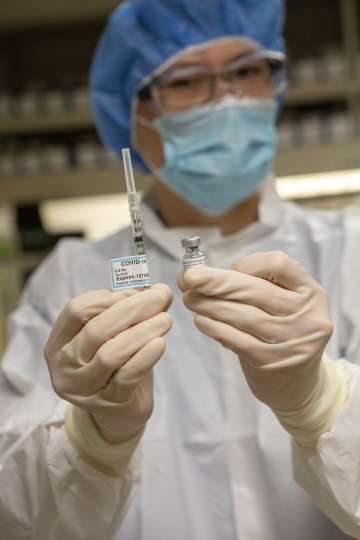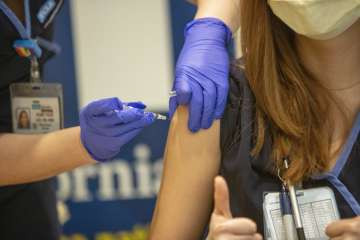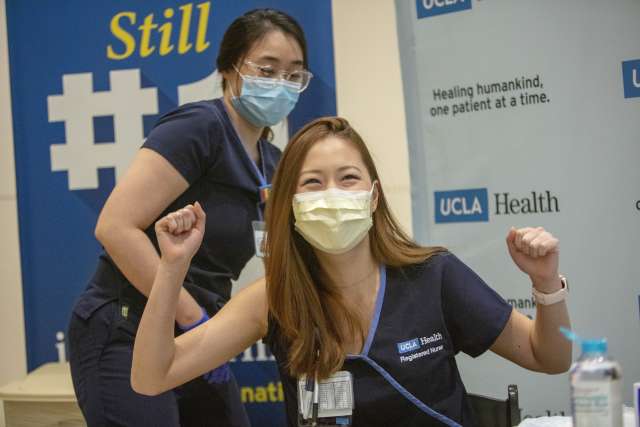Eunice Lee’s hands tremble as she stretches a pair of blue latex gloves over her fingers. As a registered nurse at Ronald Reagan UCLA Medical Center, she has given hundreds of vaccines over her career. But never one like this. Lee is preparing to administer the first COVID-19 vaccine at UCLA Health.
“I’m very honored,” the soft-spoken RN says, her eyes hinting at the smile hidden behind her mask. “I’m very excited and happy, and also kind of nervous.”
It is the week before Christmas, and in the large lobby on the B Level of Ronald Reagan UCLA Medical Center, a makeshift vaccination center is set up for frontline health care workers to receive their shots. Ten booths made of plastic sheeting stand side-by-side for the doctors, nurses, respiratory therapists, custodians and others whose jobs put them into regular contact with patients with COVID-19. These workers are the first at UCLA Health to receive a dose of Pfizer’s COVID-19 vaccine, the first to receive emergency-use authorization from the U.S. Food and Drug Administration.

The room buzzes with excited energy, and the mood, after many long, dark months of the pandemic, is celebratory. Bruin blue and gold mylar balloons bop against each other at the check-in table, and workers bubbling with anticipation arrive long before their scheduled appointments.
“I am like, ‘Please, let me go first!’ I’m so excited!” says Nicole Chang, RN, who works in the COVID-19 unit at UCLA Santa Monica Medical Center. “It’s just been a really long year for everybody, and I think this is an opportunity for us to heal together and finally get back on track to normalcy. I miss seeing people smile. I miss seeing people’s faces. I miss hugging my grandma. Those are all motivating factors as to why I want to get this vaccine.”
Suddenly, the chatty excitement in the room turns to reverent silence as a pharmacist carrying a shoebox-size container holding the initial vaccine doses steps through the door. The Pfizer/BioNTech vaccine, which arrived packed in a box filed with dry ice via a FedEx utility van the day before, must be stored at ultra-cold temperatures — minus-94 degrees Fahrenheit — then defrosted and diluted before being administered. Spontaneous applause erupts as she walks into the room, all eyes following her to a refrigerator, where the vaccine will be stored until it is time for it to be injected.
Just before 9 am, emergency department physician Medell Briggs-Malonson, MD (RES ’09, FEL ’12), MPH, removes her white coat, rolls up the right sleeve of her scrubs and takes a seat at one of the stations to be the first UCLA health care worker vaccinated. She confesses that she had been nervous that morning about getting the vaccine, a hesitation that, she says, evaporated when she arrived at the hospital and was swept up in the enthusiasm of the moment.
This is our time to help stop the pandemic,” she says to an audience of colleagues watching the momentous injection. “I’m incredibly excited. I’m very optimistic.” Lee administers the vaccine to Dr. Briggs-Malonson, and coworkers clap and cheer.
Afterward, Dr. Briggs-Malonson notes that the health care workers receiving their shots are sending a message to the broader community, many of whom have expressed hesitancy about the vaccine. “As an African American woman who is a physician, this is a signal to my community that this vaccine is safe, this vaccine is highly effective,” she says. “There is science behind it. There also is an urgency behind it because of the way COVID-19 has negatively and disproportionately affected communities of color and under-resourced communities.”

About 480 UCLA Health workers follow Dr. BriggsMalonson to receive their first dose of the two-dose Pfizer vaccine on the first day of distribution. Chang’s turn arrives, and she gives a thumbs-up as Lee pushes the needle into her arm. The pinch of the shot is nothing compared to the heartbreak that the pandemic has wrought, she says
“I’ve seen the devastation it has caused.” But now, Chang says, there is hope. “I just feel hopeful and optimistic and like there’s a light at the end of the tunnel,” she says. “But it’s not going to be just the people who are here today who are going to get the vaccination that’s going to stop this; it has to be everybody.”
Matthew Dartt, assistant director of respiratory therapy at UCLA Santa Monica Medical Center, also was among the first group to receive the vaccine. With the latest surge in COVID-19 cases, and ICU beds filling up, “everybody has been feeling down the last few weeks and like this is never going to end,” Dartt says. But now, with the Pfizer vaccine — and a second vaccine, by Moderna, receiving emergency-use authorization from the FDA a couple of days after UCLA began its vaccination program — “this feels like the light at the end of the tunnel.”
